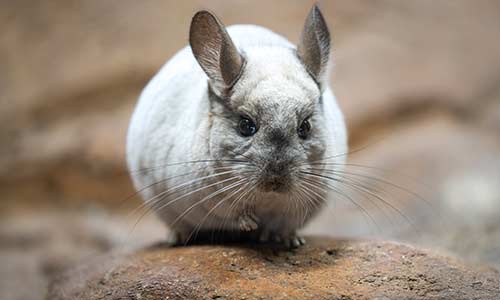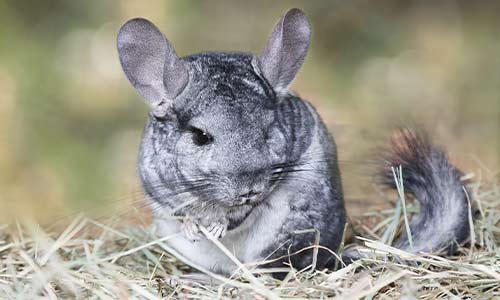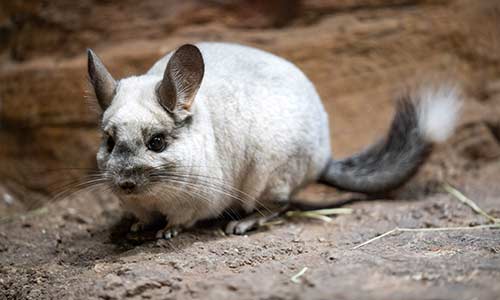Long-tailed Chinchilla
Chinchilla lanigera
About the Long-tailed Chinchilla

Geographic Range:

Class: Mammalia
Order: Rodentia
Family: Chinchillidae
Genus: Chinchilla
Species: lanigera
The chinchilla gets its name from the Chincha people of the Andes, who once wore its fur—"chinchilla" means "little chincha." These small, gray mammals are known for their soft fur, large ears, and bushy tails. Agile jumpers, they can leap up to six feet and have specialized foot pads for grasping. Chinchillas live in underground colonies and maintain their fur with dust baths, avoiding water that traps moisture. They communicate with barks and squeaks and can release fur to evade predators. Unable to sweat, their large ears help regulate their body temperature.
Committed to Conservation
Chinchillas have been relentlessly hunted for their dense, soft fur, highly prized in fashion. Over 100 pelts are needed to make a single fur coat. Since the early 1900s, they have been hunted for human apparel, with Chile exporting around 500,000 chinchilla skins annually by 1900. Considered one of the most valuable pelts in the world, their exploitation led to severe population declines. Although protective legislation was introduced in 1929, it wasn’t effectively enforced until 1983. Despite these protections, wild populations have declined by over 90% in the past 15 years. Chinchillas are still hunted in remote areas, and while they are bred commercially, reintroduction efforts have failed. Additionally, habitat loss and degradation continue to threaten their survival.
Zoos to the Rescue
Zoo New England is part of the AZA Chinchilla SAFE Program to support the protection and recovery of some of the last remaining colonies of the Critically Endangered short-tailed chinchilla, a species closely related to the long-tailed chinchilla, in Chile.
AZA’s SAFE Chinchilla Program, with support from Zoo New England, is working with the National Zoo of Chile, the Chilean Ministry of the Environment, the Corporación Nacional Forestal (CONAF), and other in-country partners to verify locations of remaining chinchilla colonies and use the data to expand and connect protected areas for population recovery.
Species Survival Plan
Zoo New England participates in the chinchilla Species Survival Plan, which is a cooperative, inter-zoo program coordinated nationally through the Association of Zoos and Aquariums (AZA). SSPs help to ensure the survival of selected species in zoos and aquariums, most of which are threatened or endangered, and enhance conservation of these species in the wild.
Chinchilla Facts
Appearance:
Chinchillas are small, gray mammals with squirrel-like bodies, large mouse-like ears, and bushy tails. They're known for their extremely soft fur—over 60 hairs grow from each follicle compared to just one in humans. Chinchillas' bare foot soles feature fleshy pads called pallipes, and their forefeet have four nimble toes for grasping. Powerful hind limbs, longer than their forelimbs, make chinchillas excellent jumpers, capable of leaping up to six feet. Their dense fur not only keeps them warm but also protects them from fleas and other pests.
Size:
Length: 9 - 14 inches (females are usually larger); tail length: 6 - 6 inches
Weight: Males weight about 1 pound, and females up to 1.76 pounds
Reproduction:
Chinchillas breed during the winter months and are mostly monogamous. They typically have two litters per year, with a gestation period of about four months. Each litter consists of one to six young, though two or three kits are most common. Born fully developed, kits are weaned at six to eight weeks and reach sexual maturity by around eight months of age.
Life Expectancy:
About 10 years in the wild
Habitat/Range:
This species is only found in the Andes Mountains of northern Chile. They live in rocky, mountainous areas from 9,800 to 16,400 feet in elevation and den in crevices and holes.
Diet:
Chinchillas are primarily herbivores, feeding on a variety of plant materials like seeds, grasses, leaves, roots, lichens and mosses. Occasionally, they may also eat insects and eggs when available. Chinchillas' incisors grow continually, and chewing enables them to wear them down appropriately.
Behavior:
Chinchillas are nocturnal and live in underground colonies, or herds, ranging from a few to over a hundred individuals. In the wild, they often dig burrows beneath or within Cardon plants, a type of succulent bromeliad. Known for their “dust baths,” chinchillas use fine dust from pumice or volcanic rocks to maintain their soft coat and remove oils and dirt. Chinchillas avoid getting wet, as their dense fur traps moisture and prevents proper drying.
When frightened, chinchillas communicate with barks and squeaks. Females can spray urine as a defense mechanism, and all chinchillas can release clumps of fur to evade predators.
Chinchillas can't sweat and are prone to overheating. Their large ears help regulate body temperature by dissipating heat.
Threats:
Being small rodents, chinchillas are a common prey species for snakes, birds of prey and many other mammals.
You Can Find This Animal in the Windows to the Wild
SAFE: Saving Animals From Extinction
From our blog
You might also like
At Franklin Park Zoo:
At Stone Zoo:










